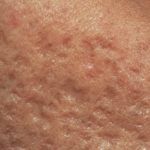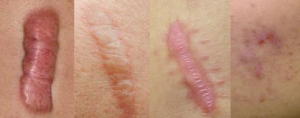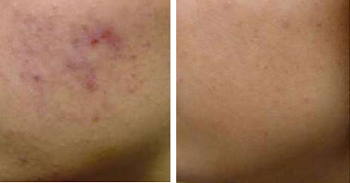Scars tend to appear on the skin during the healing process of an injury or cut of some sort. While scars are part of the healing process, there are different types of scars that vary in their appearance on the skin.
Flat and Pale Scars
The scars that look flat and pale are the most common type of scars found on the body. They form as a natural part of the healing process of the body. The scars are not always flat and pale when they first form. In fact, there is a good chance that they might be dark, raised or red after the wound is first healed. However, they will become pale and flat as time passes.
The change from red and raised to flat and pale can take up to two years to complete. Even after the healing process is complete, there will always be some evidence of the original wound. Overall, this type of scar is not usually painful but it can be itchy as well as unsightly.
Keloid Scars
Keloid scars are characterized by being raised above the skin as well as their size. They can also often be itchy, painful, tender and burning. This type of scar occurs when too much collagen is produced at the wound site and the scar keeps growing even after the actual wound has healed. It is basically an overgrowth of tissue. Overall, a new keloid scar can be either purple or red but it will become pale as time passes. They are most likely to form on the upper back, the upper arms and shoulders or around the sternum.
Hypertrophic Scars
Much like keloid scars, hypertrophic scars are also a result of too much collagen production in a wound that is healing. However, they do not extend any further than the boundaries of the original wound which is a typical feature of keloid scars. A hypertrophic scar is characterized by being red and raised and can continue to become thicker for up to six months.
Hypertrophic scars also become pale and flat as time passes. These scars can restrict some movements due to the scar tissue not being as flexible as the original skin. While they eventually become flat and pale, the overall redness can persist for a number of years.
Pitted/Sunken Scars
Also known as “Ice Pick” scars, these are the result of conditions such as chickenpox or acne can have an appearance that is best described as pitted or sunken. It’s not just skin conditions that can cause scars with this appearance. Injuries which include the loss of any underlying fat have been known to cause this type of scar.
Pitted scars don’t normally fade away as time passes. However, there are a number of treatments that can be used to try and reverse or mask the scars. Some of these treatments include topical creams to boost collagen, dermabrasion to sand away the top layers of the skin with a brush in order to allow new cells to develop and laser resurfacing which can get rid of the damaged layer of skin so new cells can develop where the damaged skin was located.

 concentrated beams of light to the area of skin while removing the skin in layers. The new skin that is formed during healing will appear youthful and tighter. This process takes about 2 weeks.
concentrated beams of light to the area of skin while removing the skin in layers. The new skin that is formed during healing will appear youthful and tighter. This process takes about 2 weeks.
 Microdermabrasion is a popular procedure being done to help reduce the appearance of acne scars. This procedure also leaves ones skin looking brighter and softer. It can be performed with all skin types and tones.
Microdermabrasion is a popular procedure being done to help reduce the appearance of acne scars. This procedure also leaves ones skin looking brighter and softer. It can be performed with all skin types and tones.